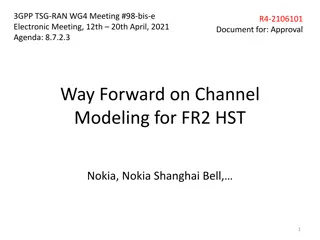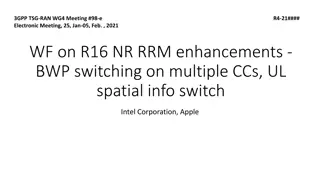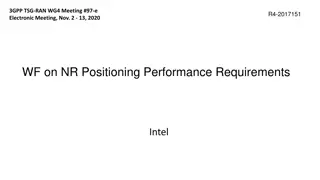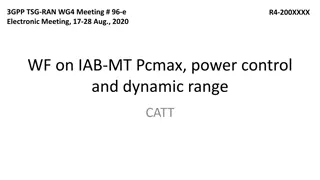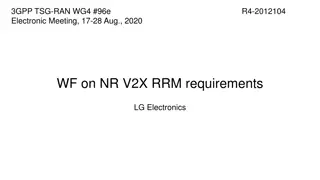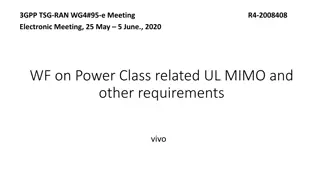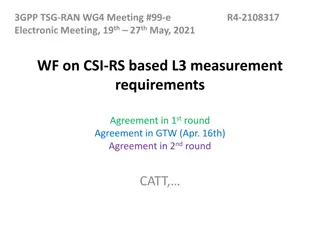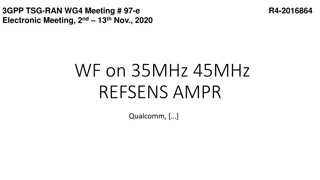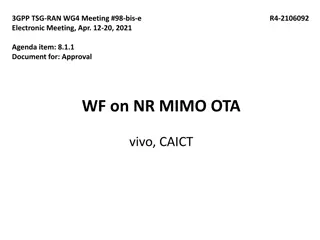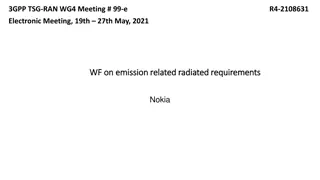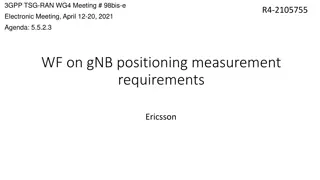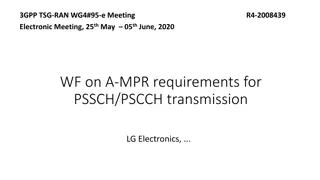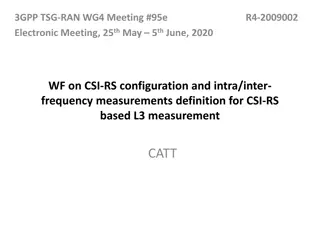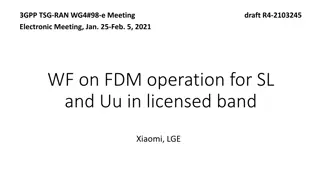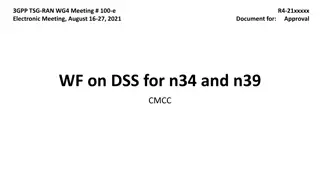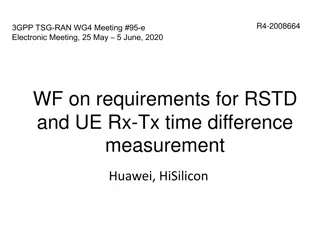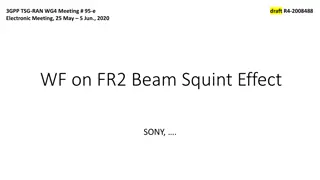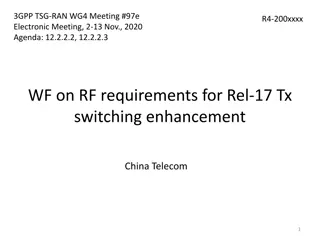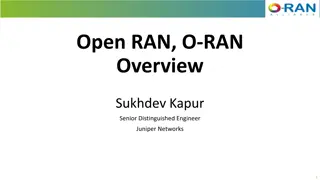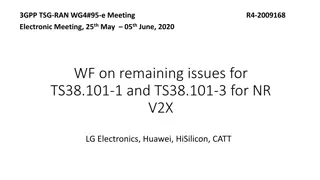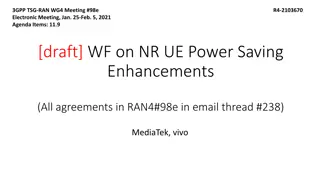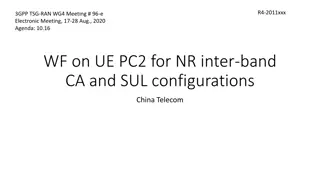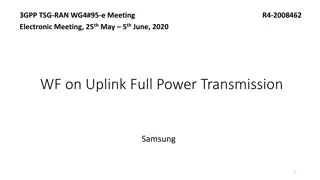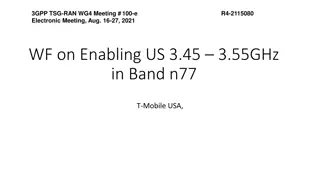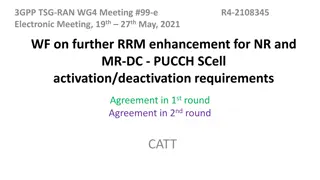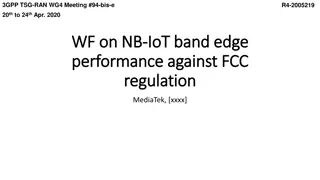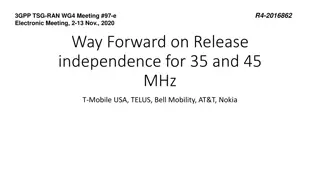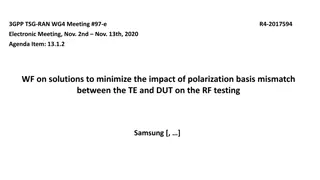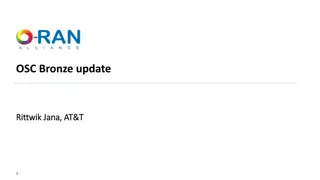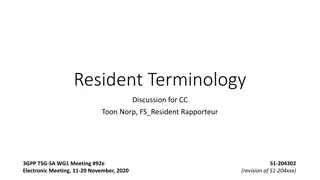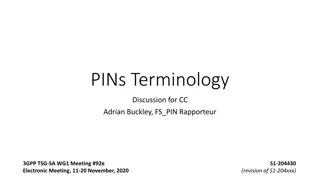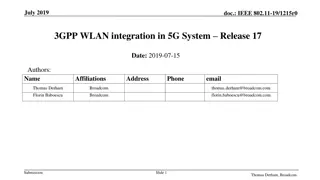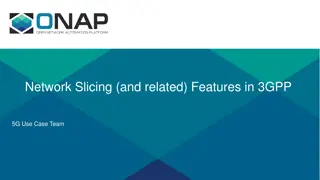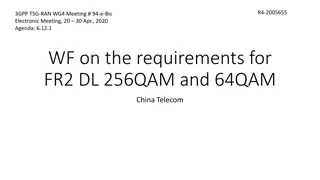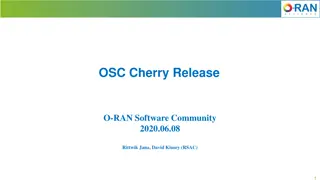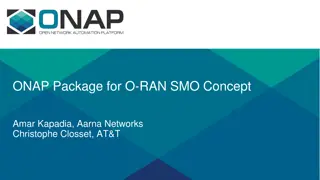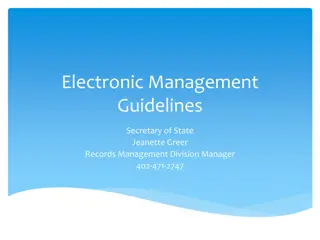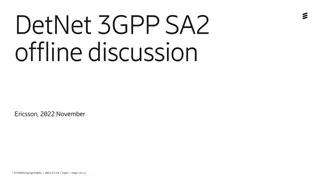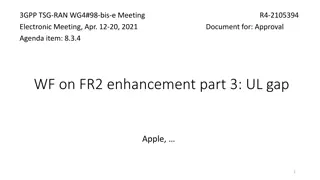3GPP TSG-RAN-WG4 Meeting #94e-bis Electronic Meeting Summary
The electronic meeting discussed RF requirements for switching between two uplink carriers, with a focus on DL interruption applicability for various duplex mode combinations. Feedback and approvals from previous meetings were also highlighted. Discussions on UE capabilities on DL interruption were explored, with different options presented by various companies. Workflows were proposed for defining UE capabilities and managing DL interruption for specific band combinations. The meeting concluded with ongoing discussions on DL interruption applicability and its implications on UE performance.
Download Presentation

Please find below an Image/Link to download the presentation.
The content on the website is provided AS IS for your information and personal use only. It may not be sold, licensed, or shared on other websites without obtaining consent from the author. Download presentation by click this link. If you encounter any issues during the download, it is possible that the publisher has removed the file from their server.
E N D
Presentation Transcript
3GPP TSG-RAN WG4 Meeting #94e-bis Electronic Meeting, 20 - 30 Apr., 2020 Agenda: 6.13.1.5 R4-200xxxx Way forward on RF requirements for Tx switching between two uplink carriers China Telecom 1
Background Approved WFs in the previous meetings R4-1913041, RAN4 #92bis R4-1916084, RAN4 #93 R4-2002815, RAN4 #94e 2
Background on Applicability of DL interruption RAN4 #94e Agreement (Feb 2020): For the following duplex mode combinations, no DL reception interruption (carrier 1 + carrier 2): SUL+TDD TDD+TDD CA with the same UL-DL pattern TDD+TDD EN-DC with the same UL-DL pattern For other duplex mode combinations, define different capabilities for UEs with and without DL interruption depending on the RAN1 feedback. .. Send LS to RAN1 and ask RAN1 s feedback on RAN1 spec impact if there is DL reception interruption in some scenarios. RAN1 #100bis-e (Apr 2020): RAN1 approved the reply LS to RAN4 in R1-2002960: RAN1 Answer: For UL Tx switching, there is no RAN1 specification impact on DL interruption. There may or may not be performance impacts due to DL interruption, but RAN1 did not analyze these further. 3
Background on Applicability of DL interruption RAN4 94e-bis (Apr 2020): For duplex mode combinations excepting SUL+TDD and TDD+TDD with the same UL- DL pattern, RAN4 further discussed whether to introduce UE capability on DL interruption. According to the 1stround email discussion summary in R4-2005101, companies positions are as follows: Option 1: Define different capabilities for UEs with and without DL interruption (CMCC, ZTE, OPPO, Huawei, China Telecom, CHTTL, Apple MediaTek, vivo, CATT, Qualcomm) Option 1a: Whether to allow DL interruption for each band combination can be discussed later after the signaling for DL interruption is defined. (CMCC, Huawei, China Telecom, CHTTL, Apple, MediaTek, CATT, Qualcomm) Option 2: In Rel-16, only enable this feature for the band combinations that can avoid DL interruption, i.e., no interruption in DL reception are allowed. (Nokia, MediaTek, CATT) Option 2a (MediaTek, CATT) Introduce a band combination table or add a column in the CA/EN-DC table to indicate the support of this feature for each band combination. The WI can be closed if there is at least one combination is included. Option 2b (MediaTek, CATT) Introduce the below criteria of no DL interruption. Band combinations violate the criteria does not need to support switching capability. FGAP > 200MHz separation when TDD band <=2GHz. FGAP > 400MHz when 2GHz <=TDD band <=4GHz. FGAP > 800MHz when TDD band >=4GHz. 4
WF on Applicability of DL interruption For duplex mode combinations excepting SUL+TDD and TDD+TDD with the same UL-DL pattern, define different capabilities for UEs with and without DL interruption UE capability is reported per DL band in each band combination for each UL band pair supporting Tx switching. For UE reporting DL interruption, the RRM interruption requirements defined in RAN4 shall be applied. Whether to allow DL interruption for each band combination can be discussed later in RAN4 after the signaling for DL interruption is defined. Send the above information to RAN2 in this meeting. 5
WF on CR drafting Rank adaptation UL-MIMO Option 1 (baseline): keep the agreement in RAN4 #94e, i.e., Capture the following RAN4 #93 agreement as normative text in 38.101-1 and 38.101-3 For UE supporting UL Tx switching, it is mandated to support 2- layer UL-MIMO transmission and single-layer transmission on carrier 2 following the BS scheduling and rank adaptation (if rank adaptation is applicable). Option 2: Capture the following text as normative text in 38.101-1 and 38.101-3 The UE indicating support for the switching between single-layer transmission [with one antenna port] and two-layer transmission [with two antenna ports] on two uplink carriers configured in different NR bands shall be able to transmit both two-layer and single-layer transmissions on the uplink carrier with two-layer transmission. 6
WF on CR drafting Clarification on power class Agree the following tentative agreements listed in the 1st round email discussion summary in R4-2005101. Add the following clarification on power class in 38.101-1 and 38.101-3: Power class declaration for the uplink transmission switching follows the general definition of power class, and is not changed due to the dynamic switching between the two uplink carriers. No clarification on power class in time mask requirements for Tx switching Discussion can be continued based on contribution driven. 7
Thanks! 8


